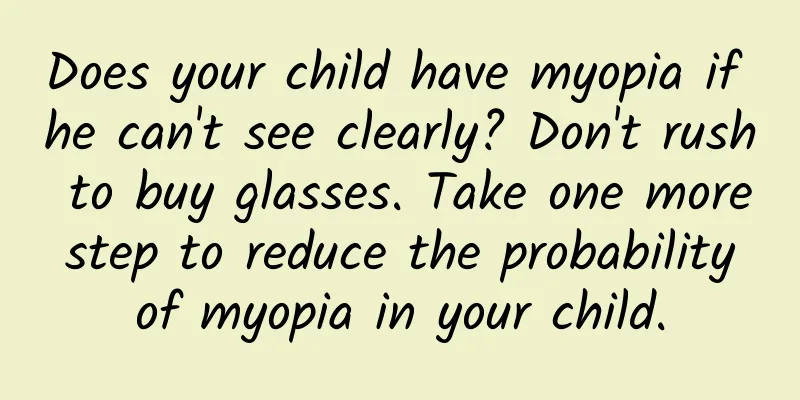Does your child have myopia if he can't see clearly? Don't rush to buy glasses. Take one more step to reduce the probability of myopia in your child.

|
Year after year, there seem to be more and more children with myopia around us. Not surprisingly, this is closely related to the widespread use of mobile phones, computers, and iPads. Children are exposed to electronic screens more and more, and their age is getting younger and younger. They generally use their eyes too much, and myopia prevention and control is receiving more and more attention from the country and society. In recent years, myopia, strabismus and astigmatism have become more common among young children. More and more children have started to have "inability to see clearly" since elementary school. They are bound by thick glasses frames at a young age. Is myopia in children really unavoidable? Actively prevent and control myopia and stay away from myopia misunderstandings. As the "gatekeepers" of myopia prevention and control for adolescents, parents must be aware of these misunderstandings! Myth 1: Do you need to wear glasses if you can’t see clearly? The reasons that cause children to have blurred vision are not only myopia, but also pseudomyopia, astigmatism, moderate to high hyperopia or some pediatric eye diseases, which may affect vision and cause blurred vision. When you discover your child has vision abnormalities for the first time, you should take him or her to a regular ophthalmology hospital for examination and diagnosis as soon as possible. If it is confirmed to be myopia, you can then get glasses for correction. Myth 2: Young people are less likely to become myopic In recent years, the age of myopia onset has significantly advanced. From the perspective of age groups, the myopia growth rate of children aged 6 to 10 is higher than that of children aged 11 to 18. Therefore, myopia prevention should be started as early as possible. Myth 3: Children with myopia only need to wear glasses On the one hand, according to the doctor's advice, wear glasses to correct myopia in combination with the results of medical optometry. At the same time, correct bad eye habits, increase daytime outdoor activities, and control the progression of myopia. On the other hand, by establishing and improving refractive development files, patients go to the hospital for optometry review every 3 to 6 months . Combined with data such as visual acuity, eye position, eye axis, corneal curvature, etc., they can timely understand the changes in eye development and visual acuity, and intervene and control them in a timely manner. Myth 4: You can get glasses at any ordinary optical shop Children's ciliary muscles have strong adaptability, and simple computer optometry cannot accurately obtain the child's true myopia degree. For most children, mydriasis refraction performed by a formal institution can eliminate the influence of over-accommodation on the refraction results, thereby obtaining accurate refractive power , formulating a suitable myopia correction plan, and delaying the progression of myopia. Myth 5: Ordinary glasses can prevent myopia from rapidly worsening In addition to genetic factors, the main causes of myopia are bad eye behavior and environment, such as continuous close-up eye use, lack of outdoor activities, and incorrect eye posture. To prevent myopia from getting worse, we must start with eye hygiene and the development of scientific eye habits. In addition, insist on regular eye examinations , or combine the doctor's advice to use corneal reshaping lenses and other scientific control methods. Myth 6: Children cannot undergo myopia surgery to correct their vision From a medical point of view, if an eye examination shows that the conditions for myopia surgery are met, myopia can be corrected through myopia surgery. However, adolescents and children are in the stage of physical development and their myopia is unstable. It is recommended to wait until the myopia is stable after adulthood, and then make a decision based on personal wishes, professional examinations and specialist evaluations . Eyes are the windows to the soul. I hope all young people can avoid the misunderstanding of myopia and have a clear and bright future! Source: Aier Eye Hospital |
Recommend
Can I eat brown rice during my period?
Brown rice is a common ingredient in our daily li...
What should women do if they have hemorrhoids? Do these things well
Hemorrhoids are a common anorectal disease in cli...
How many of the ten blind spots in preventing and treating COVID-19 do you know?
Omicron has a low toxicity and will not cause sub...
Why do I fart a lot after giving birth?
Farting is a phenomenon that happens frequently t...
Can people with claustrophobia undergo an MRI?
Claustrophobia is an anxiety disorder in which pa...
What are the characteristics of Bailu? Meteorological changes during the Bailu solar term
There is a saying among the people that "the...
Will my belly hurt when I'm pregnant?
There are many symptoms during pregnancy, especia...
Can women take a bath every day during early pregnancy?
Being pregnant for ten months is a particularly d...
What causes premenstrual vulvar itching?
Many women will feel vulvar itching before menstr...
Is it good to drink milk tea every day? How to drink milk tea without gaining weight
Milk tea is a very popular drink among young peop...
How to treat vaginal bleeding during pregnancy
Pregnant women must be well equipped, get enough ...
Is it better to grow Podocarpus in a deep pot or a shallow pot? What kind of flower pot is most suitable for growing Podocarpus?
Podocarpus is a common ornamental plant in China....
What should women eat for postpartum high blood pressure?
Hypertension is a symptom that we are all very fa...
I don't have my period and I'm not pregnant, what's going on?
Women after puberty will automatically have menst...
I didn't know I was pregnant and kept working out
In order to maintain a perfect body, many female ...









